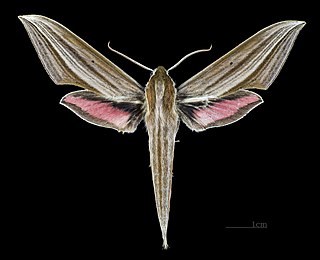Related Research Articles

The triquetral bone is located in the wrist on the medial side of the proximal row of the carpus between the lunate and pisiform bones. It is on the ulnar side of the hand, but does not articulate with the ulna. It connects with the pisiform, hamate, and lunate bones. It is the 3rd most commonly fractured carpal bone.

The yellow-and-black triplefin, Forsterygion flavonigrum, a triplefin of the genus Forsterygion, is found around the north of the North Island of New Zealand at depths of between 15 and 30 m, in reef areas of broken rock. Its length is between 4 and 7 cm.

Curetis bulis, the bright sunbeam, is a species of butterfly belonging to the lycaenid family. It is found in Asia.

Cutaneous innervation refers to the area of the skin which is supplied by a specific nerve.

Cutaneous innervation refers to the area of the skin which is supplied by a specific nerve.

Xylophanes eumedon is a moth of the family Sphingidae. It is known from Mexico.

Tickell's bat is a species of vesper bat. It can be found in the following countries: Bangladesh Bhutan, Cambodia, possibly China, India, Myanmar, Nepal, Sri Lanka and Thailand.

The lesser Asiatic yellow bat is a species of vesper bat. It is found in Bangladesh, India, Indonesia, Malaysia, Pakistan, the Philippines, Sri Lanka, and Taiwan.

Rufoclanis maccleeryi is a moth of the family Sphingidae. It is known from Tanzania and Kenya.

Xylophanes isaon is a moth of the family Sphingidae. It is found from south-eastern Brazil and Paraguay to Argentina.

Xylophanes neoptolemus is a moth of the family Sphingidae.
Cosmopterix etmylaurae is a moth of the family Cosmopterigidae. It is known from Costa Rica.

Hyperythra lutea is a moth in the family Geometridae. The species was first described by Caspar Stoll in 1781. It is found in Indian subregion, Sri Lanka, South East Asia, Sundaland.
Arctia brachyptera, the Kluane tiger moth, is a moth of the family Erebidae. It was described by James T. Troubridge and J. Donald Lafontaine in 2000 and is only known from the Yukon in Canada. It occurs in alpine tundra of the Saint Elias Mountains.

Asura arcuata is a moth of the family Erebidae. It was described by Frederic Moore in 1882. It is found in India, Indonesia, Taiwan and Japan.

Lophocampa citrina is a moth of the family Erebidae. It was described by Jan Sepp in 1843. It is found in Mexico, Honduras, Panama, French Guiana, Brazil, Venezuela and the Amazon region.
Tinoliodes dehanna is a moth in the family Erebidae. It was described by Arnold Pagenstecher in 1885. It is found in Sundaland in Southeastern Asia. The habitat consists of rain forests from the lowlands up to 1.500 meters.
Choristostigma erubescens is a moth in the family Crambidae. It was described by George Hampson in 1899. It is found in Xalapa, Mexico.
Negera unispinosa is a moth in the family Drepanidae. It was described by Watson in 1965. It is found in Malawi.

Anoteropsis hilaris, commonly referred to as the garden wolf spider, is a species of wolf spider that is endemic to New Zealand.
References
- ↑ Nuss, M.; et al. (2003–2014). "GlobIZ search". Global Information System on Pyraloidea. Retrieved July 15, 2014.
- ↑ Proceedings of the Zoological Society of London 1899: 175
| This Odontiinae-related article is a stub. You can help Wikipedia by expanding it. |